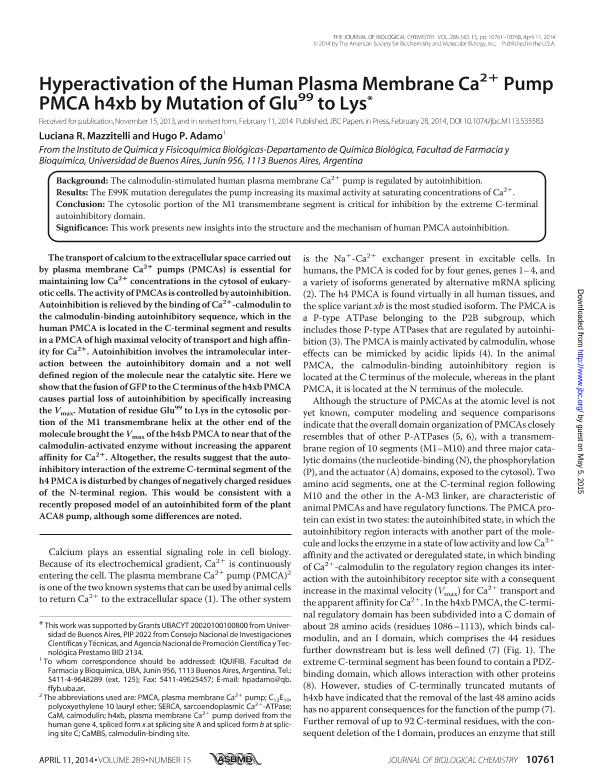Artículo
Hyperactivation of the Human Plasma Membrane Ca2+ Pump PMCA h4xb by Mutation of Glu99 to Lys
Fecha de publicación:
04/2014
Editorial:
American Society for Biochemistry and Molecular Biology
Revista:
Journal of Biological Chemistry
ISSN:
0021-9258
e-ISSN:
1083-351X
Idioma:
Inglés
Tipo de recurso:
Artículo publicado
Clasificación temática:
Resumen
The transport of calcium to the extracellular space carried out by plasma membrane Ca2+ pumps (PMCAs) is essential for maintaining low Ca2+ concentrations in the cytosol of eukaryotic cells. The activity of PMCAs is controlled by autoinhibition. Autoinhibition is relieved by the binding of Ca2+-calmodulin to the calmodulin-binding autoinhibitory sequence, which in the human PMCA is located in the C-terminal segment and results in a PMCA of high maximal velocity of transport and high affinity for Ca2+. Autoinhibition involves the intramolecular interaction between the autoinhibitory domain and a not well defined region of the molecule near the catalytic site. Here we show that the fusion of GFP to the C terminus of the h4xb PMCA causes partial loss of autoinhibition by specifically increasing the Vmax. Mutation of residue Glu99 to Lys in the cytosolic portion of the M1 transmembrane helix at the other end of the molecule brought the Vmax of the h4xb PMCA to near that of the calmodulin-activated enzyme without increasing the apparent affinity for Ca2+. Altogether, the results suggest that the autoinhibitory interaction of the extreme C-terminal segment of the h4 PMCA is disturbed by changes of negatively charged residues of the N-terminal region. This would be consistent with a recently proposed model of an autoinhibited form of the plant ACA8 pump, although some differences are noted.
Palabras clave:
P-Atpase
,
Autoinhibition
,
Calcium
,
Calmodulin
Archivos asociados
Licencia
Identificadores
Colecciones
Articulos(IQUIFIB)
Articulos de INST.DE QUIMICA Y FISICO-QUIMICA BIOLOGICAS "PROF. ALEJANDRO C. PALADINI"
Articulos de INST.DE QUIMICA Y FISICO-QUIMICA BIOLOGICAS "PROF. ALEJANDRO C. PALADINI"
Citación
Mazzitelli, Luciana Romina; Adamo, Hugo Pedro; Hyperactivation of the Human Plasma Membrane Ca2+ Pump PMCA h4xb by Mutation of Glu99 to Lys; American Society for Biochemistry and Molecular Biology; Journal of Biological Chemistry; 289; 15; 4-2014; 10761-10768
Compartir
Altmétricas




